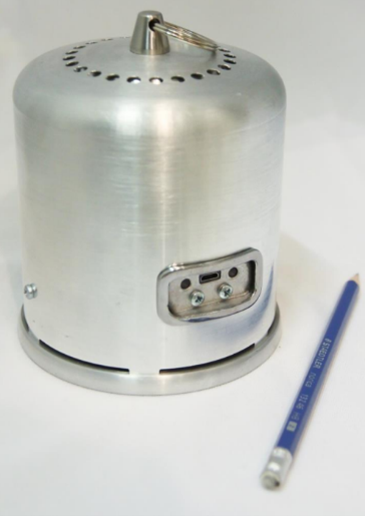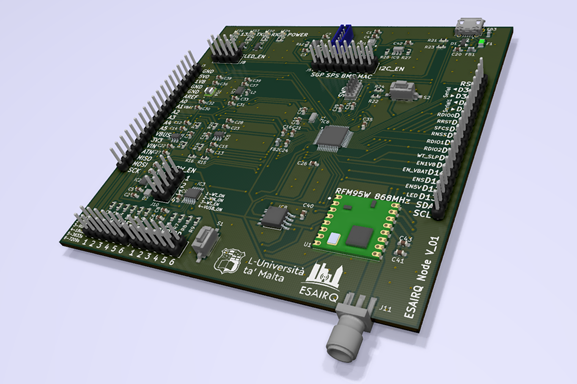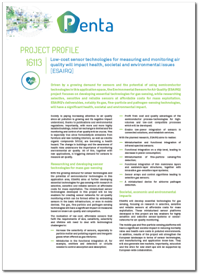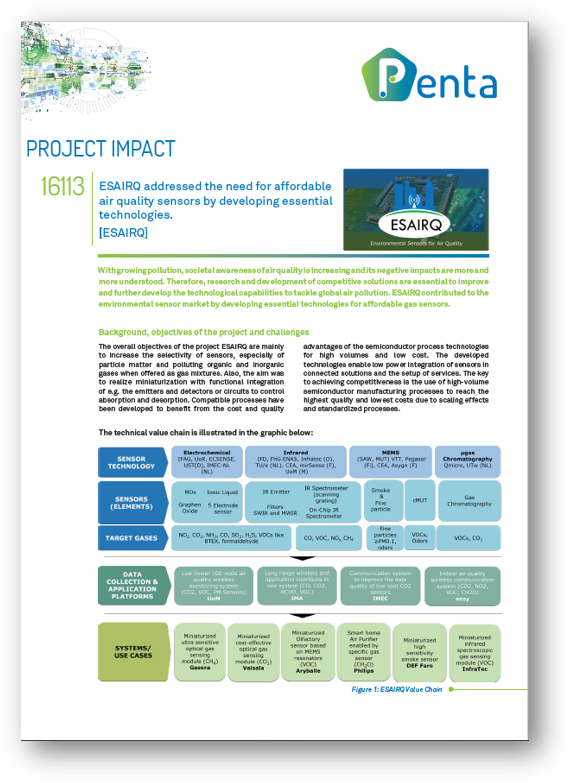Call :
PENTA Call 2
Project status :
Completed
Project website :
https://www.project-esairq.com/
Key application areas
 Health & Well-Being
Health & Well-Being  Automotive and Transport (future)
Automotive and Transport (future) Essential capabilities
 Systems and Components Architecture, Design & Integration
Systems and Components Architecture, Design & Integration
Connectivity & Interoperability
 Safety, Security & Reliability
Safety, Security & Reliability  ECS Process Technology, Equipment, Materials & Manufacturing
ECS Process Technology, Equipment, Materials & Manufacturing
PARTNER
ASYGN / Afore Oy / Aryballe Technologies SA / CEA / EC-Sense GmbH / Eindhoven University of Technology / FARE / Fraunhofer ENAS / Gasera Ltd / IMEC / Holst Centre / INSTITUT MIKROELEKTRONICKYCH APLIKACI S.R.O. / Infineon Dresden / Infineon Technologies AG / InfraTec GmbH Infrarotsensorik und Messtechnik / Pegasor Oy / Philips Consumer Lifestyle B.V. / Philips Electronics Nederland BV / Qmicro BV / Soitec SA / UST Umweltsensortechnik GmbH / University of Malta / University of Regensburg / University of Twente / VTT Technical Research Centre of Finland Ltd / Vaisala Oyj / eesy-innovation GmbH / mirSense SAS
ASYGN / Afore Oy / Aryballe Technologies SA / CEA / EC-Sense GmbH / Eindhoven University of Technology / FARE / Fraunhofer ENAS / Gasera Ltd / IMEC / Holst Centre / INSTITUT MIKROELEKTRONICKYCH APLIKACI S.R.O. / Infineon Dresden / Infineon Technologies AG / InfraTec GmbH Infrarotsensorik und Messtechnik / Pegasor Oy / Philips Consumer Lifestyle B.V. / Philips Electronics Nederland BV / Qmicro BV / Soitec SA / UST Umweltsensortechnik GmbH / University of Malta / University of Regensburg / University of Twente / VTT Technical Research Centre of Finland Ltd / Vaisala Oyj / eesy-innovation GmbH / mirSense SAS
Countries involved
 Finland
Finland  France
France  Germany
Germany  Netherlands
Netherlands  Czech republic
Czech republic  Malta
Malta Project leader(s)
Fabiola Bermudez-ElsingerKey project dates
21 June 2018 to 20 June 2021ESAIRQ addressed the need for affordable air quality sensors by developing essential technologies for gas sensing, contributing to the research of selective, sensitive, and reliable sensors [ESAIRQ]
With growing pollution, societal awareness of air quality is increasing and its negative impacts are more and more understood. Therefore, research and development of competitive solutions are essential to improve and further develop the technological capabilities to tackle global air pollution. ESAIRQ contributed to the environmental sensor market by developing essential technologies for affordable gas sensors.
Background, objectives of the project and challenges
The overall objectives of the project ESAIRQ are mainly to increase the selectivity of sensors, especially of particle matter and polluting organic and inorganic gases when offered as gas mixtures. Also, the aim was to realize miniaturization with functional integration of e.g. the emitters and detectors or circuits to control absorption and desorption. Compatible processes have been developed to benefit from the cost and quality advantages of the semiconductor process technologies for high volumes and low cost. The developed technologies enable low power integration of sensors in connected solutions and the setup of services. The key to achieving competitiveness is the use of high-volume semiconductor manufacturing processes to reach the highest quality and lowest costs due to scaling effects and standardized processes.
Summarized, the technical objectives of ESAIRQ are:
- To research and develop highly miniaturized gas sensors to increase selectivity and sensitivity to toxic and harmful gases, allergens, pathogens, particulates and particulate matter.
- The research and development of sensor packaging and heterogeneous integration technologies for miniaturized low-power sensor systems.
- Research of signal algorithms for highly selective multi-gas sensors.
- Elimination of cross-sensitivities.
The innovation strength for new solutions was enhanced by the cooperation between applications owners (e.g. air purifiers) & SME companies with new business models and leading-edge providers for technology (sensors, connectivity). Therefore, the project enables new sensor technologies to be available in the European manufacturing landscape. Also, it improves system knowledge for connected sensor systems and related applications. The outcomes are, thus, strengthening the further research based on first successful implementations and will stimulate the development of new applications.
The technical value chain is illustrated in the graphic below:

Figure 1: ESAIRQ Value Chain
Technological achievements
ESAIRQ delivered technical prototypes for electrochemical gas sensors, micro gas chromatography, smoke and fine particle sensors, photoacoustic detection, resonant cMUT sensors, as well as infrared spectrometer technologies.

Figure 2: A selection of the developed sensor technologies within ESAIRQ.
Therefore, technology breakthroughs are achieved for the following applications:
- Smart Home – air purifier application: Target gases are formaldehyde, benzene, toluene, xylene. Guideline is the Chinese standard GB/T 18883-2002. Detection limits 10 times lower than the limits in this standard are required, for formaldehyde, benzene, and for toluene and xylene.
- Smart Home – Indoor Connectivity: Target gases are VOC, CO2, CO, NOx, and the sensor advancements were achieved in the domains of sensitivity, selectivity, power consumption, battery lifetime, as well as costs and form factor.
- Smoke detection: Technological breakthroughs were achieved in a better selectivity and reliability, development of an assembly procedure following System-in-Packaging integration approaches, as well as reducing form factor, power consumption, and fab costs.
- Odor detection: Electronic noses can play a fundamental role by identifying leakage from chemical plants, changes in the organic content of waste water, water contamination. Sensor arrays and control algorithms will lead to selective and miniaturized gas sensors, including MUT (Micromachined Ultrasonic Transducers) based components, allowing obtaining the “signature” of a set of gases associated with an odour.
- Industrial application: Development of an efficient, low-power, and robust air quality monitoring system, consisting of a smart wireless network of gas sensors and associated data storage and analysis. NDIR gas detection has previously exploited full-plastic modules with whole system open to the measured space. In ESAIRQ, IR-window sealing of the detection electronics, in a duct probe, was introduced in cost-effective plastic molding. Plastic optics was further brought into chip-level IR-signal collection. A wide-band reflector component replaces the dispersive IR lens and expands the wavelength range in NDIR gas-detection

Figure 3: Indoor Air Quality Sensor with integrated micropumping system to enable HVAC applications for industrial use cases / pegasor
Miniaturization leads to a decrease in power consumption and a good application perspective for mobile devices. The functional integration enhances the detection capabilities (number of accessible gases) and leads to more selective sensors. Both applied to infrared spectral sensors on-chip level enable more selectivity and extended detection capabilities (number of accessible gases). Sensor arrays and control algorithms applied to selective gas sensors, including MUT-based components, allow obtaining the “signature” of a set of gases associated with an odor. Based on available connectivity solutions, the new sensors have been integrated with a focus on high-efficiency performance, which means low energy consumption and a highly efficient wireless communication protocol. The development of common communication interfaces ensures the proper interoperability of different sensors and systems. Close cooperation will minimize the efforts to set up networked sensor solutions with the previously mentioned characteristics.

Figure 4: A sensor node for the indoor air-quality monitoring system developed by the University of Malta / University of Malta
Market Potential
The COVID-19 pandemic has significantly increased the demand and importance of indoor air quality monitoring. Although the market for environmental sensors and applications around air quality is a relatively new, it is a rapidly growing market. The air quality monitoring market is expected to register a CAGR of 5.79% during the forecast period of 2021 – 2026 and is expected to value USD 5.79 billion in 2026 from USD 4.20 billion in 2020. The global market for air treatment in 2020 was 3 billion US$. Air Purifier products account for the majority of this by growing 5% per year. (Source: Mordor Intelligence 2020, Air Quality Monitoring Market). Since the WHO has sharpened the air quality guidelines, technologies that lead to a drastic reduction in cost and enable high-volume manufacturability for selective sensors are needed and enable new application scenarios. This holds a high exploitation potential for all European partners who are on the one hand on the manufacturer side and on the other hand in the field of application. Target markets are the environmental MEMS sensor market, gas and temperature sensor market as well as new applications such as smart homes. An example of emerging market is the regulated vehicle inspection, starting in July 2022 in Netherlands and expected to expand to other EU countries. Nanoparticle detection technology developed in the project was adopted to an inspection instrument and has been already certified for the market.
Societal & Economic Impact
The miniaturized sensor platforms developed in this project are key enablers for highly sensitive and selective sensor systems or sensor networks for air quality monitoring. The mobile gas and fine particle sensing platforms will have a significant societal impact in case measures are derived based on the known air quality. Depending on the measures, a reduction of mortality rates and healthcare costs in polluted environments, as well as a healthier indoor climate (Fig. 6) can be achieved.
Also, the project has a positive impact on future manufacturing in Europe and on the global competitiveness, on the creation of new business based on closed gaps between technology and applications, as well as have an impact on SMEs and future perspectives for scientists by strengthening research in the specified area.
The successful conclusion of the project will enable new sensor technologies to be available in the European manufacturing landscape. It enhanced system knowledge for connected sensor systems and related applications. Therefore, it contributes to the discovery of new services based on European technologies in Europe and the rest of the world, stimulating new application developments, new business models, and new application possibilities.

Figure 4: Children in a classroom with an air-quality sensor / Schmidt Media Design A
Patents/Standardisation/ Publications
Regarding patents, a patent from the TU Eindhoven has been submitted for a multi-pixel spectral sensor. Two intended patents are currently discussed internally within VTT. Standardization activities also took place within the project, where project partners were involved in international standardization for electrical products and components on behalf of the Netherlands. In total, 12 scientific papers have been published so far, and 3 more are planned after the end of the project. 10 Ph.D.-students were involved in the project.
Future Developments
The demand for gas detection systems in the industrial sector will increase (monitoring and detection of toxic & combustible gases in the processing plants) due to the introduction of guidelines and regulations in several nations as well as sharper guidelines from the WHO. Also, there is increasing demand for controlling air quality in-cabin and for building automation. Areas of future application for exploitation are air monitoring in public and private buildings, as well as private and public transport. In this context, the early detection of dangerous situations (e.g. smoldering fires, chemical accidents, leaks) is important and needs further development. Also, the development of algorithms and software to solve the multiple gas detection is still challenging. Regarding climate change, advancing technologies to find greenhouse gas leaks, especially for SF6 (electrical insulation), CH4 (natural gas mining and transport), is crucial to fight global warming.






